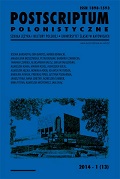Wampir i namiętny cyborg – z psychoanalizy dwóch przypadków zauroczenia przez femme fatale
Vampire and passionate cyborg – psychoanalysis of the two man infatuated by femme fatale
Author(s): Jan ZającSubject(s): Language and Literature Studies
Published by: Wydawnictwo Uniwersytetu Śląskiego
Keywords: Władysław Stanisław Reymont; Jerzy Sosnowski; men studies; Freudian psychoanalysis; British school of psychoanalysis
Summary/Abstract: Both novels analysed in the article (Władysław Reymont’s "Vampire" written at the beginning of the 20th century and contemporary "Apokryf Agłai" by Jerzy Sosnowski) present the fall of a man seduced by a demonic woman. Daisy (a vampire) and Lilka-Agłaja (a cyborg) are capable, due to their dangerous beauty, of destroying men’s careers, family life, hapiness and sanity. In these texts femininity is traditionally described as something monstrous and dangerous. A psychoanalytical reading (which follows Klein and Freud) leads to a categorization of the sources of such stereotypical images. The mental states of the characters, as described in both novels, are very similar. The regressive symptoms are highlighted – men’s psyches regress to the paranoid and schizoid state, where primary mechanisms of defence seem to dominate. The images of the femme fatale are influenced by the projection of a split, negative object. They aim at preventing an object from final destruction. The author of the article creates a hypothesis that patriarchal culture influences the defence strategies used by the heroes of both novels. Pariarchal culture represses men that show weakness and denies them the right to be called men. However, it accepts weaknesses when they are disguised as misogynistic attitudes. If a man cannot accept weakness, as belonging to him, he must make a woman responsible for it (even on the level of subconscious defence strategies).
Journal: Postscriptum Polonistyczne
- Issue Year: 13/2014
- Issue No: 1
- Page Range: 135-145
- Page Count: 11

